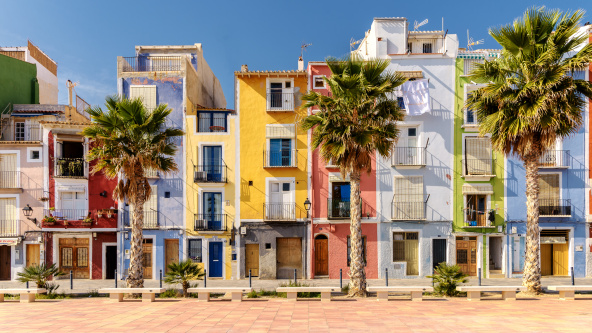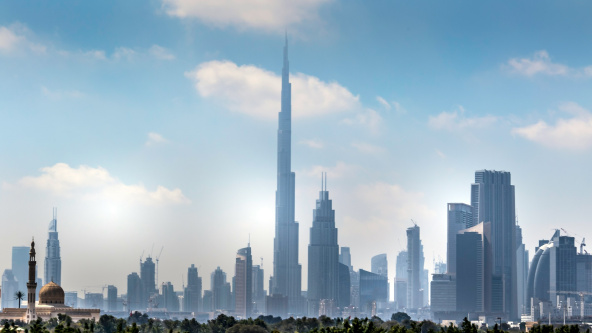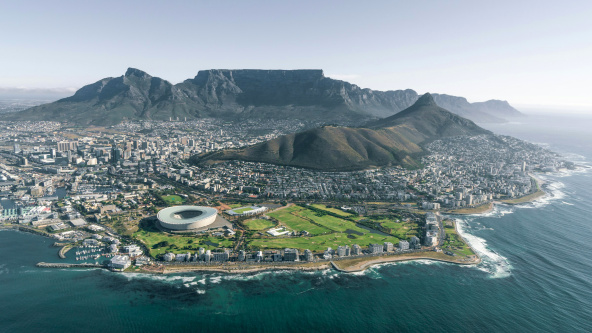Living on the Costa Blanca: an expat guide

What to expect when moving to the Costa Blanca
The Costa Blanca offers numerous villages, towns, and even cities to choose from.
Alicante is the up-and-coming city in the region, with a strong food and drink scene thanks to its vineyards and famous grape-growing (the top choice for the New Year tradition of grape eating in Spain) farms, and a more prominent Spanish feel than its northerly neighbour Benidorm. It also offers the shopping and multicultural benefits of Valencia whilst being smaller and with easier access to nature.
Benidorm remains the English hub in the area, and the nightlife is second to none. Just a little way north along the coast, however, you can be immersed in the stunning Costa Blanca coastline and beaches in towns like Calpe, Xativa, and Denia. These three small towns are filled with padel and tennis clubs, Pilates classes on the beach, stand-up paddle-boarding in the water, and long promenades full of rollerbladers and runners, and are overlooked by mountain roads full of hikers and cyclists. The whole area is perfect for active families that want to get away from big city life, whilst still having access to everything that you need.
Where to live in the Costa Blanca
Choosing where to live on the Costa Blanca can be helped by desired proximity to the cities of Benidorm or Alicante, how international you would like to feel, and your favourite sport or activity. Go to Torrevieja, for example, and you will find a long-established expat community of English, Ukrainians, and Russians, multiple golf clubs to join, and the benefit of hot weather from the neighbouring region of Murcia.
Although long known as a place to retire or ‘get away from it all,’ the Costa Blanca is, in fact, a young, active region with something to offer everyone.
Alicante and its surrounding towns are more balmy and leafy, with ample opportunity to practice Spanish whilst maintaining easy access to English-speaking doctors and legal services, and in Javea and Denia, there is the mixed international community who live a relaxed Spanish life in multiple languages. Javea is where you will find the sought-after Lady Elizabeth School, the English International School in Benitachell, in the province of Alicante.
If you’re looking for a school abroad, our expert consultants can advise on all aspects of international education, from schools to local educational scenes.
Getting started in the Costa Blanca
There is no shortage of advice on various expat groups and social media hubs for the Costa Blanca region. Legal help, movers, and real estate agents are available in abundance, and they speak most languages that you will ever need. Deciding whether to choose small-town living, mountain escape, or city apartment will help you find your community. Most banks and larger doctor offices speak English, although for day-to-day cafe life and speaking to neighbours it would be beneficial to have some Spanish phrases to hand.
Day-to-day living in Costa Blanca
Life on the Costa Blanca is predominantly car-based, although there are buses between Denia and Alicante, taking in the coastal towns and all the way up to Valencia, plus a main train line connecting Alicante to Valencia. With a car, you have access to the mountains and the coast, as well as everything in between. Alicante has most of the international chains you can wish for, and there are several English and international supermarkets along the Costa Blanca stretch.
Although Benidorm takes the crown for nightlife, Alicante also has a young, partying side. Alicante hosts the raucous Hogueras de San Juan de Alicante, between the 20th and 24th of June, with enormous statues, bonfires, midday firecracker displays known as mascletas, and large monuments known as ‘fogueres’ (bonfires). The festival has a lot of similarities to Valencia's famous Fallas festival, which takes place in March.
Sport clubs are everywhere in the Costa Blanca. Padel, tennis, golf, yoga, pilates, stand-up paddle boarding, hiking, and cycling all take place on an average day to varying degrees and abilities. The best road cycling teams in the world head to Calpe to train in their off-season, and at the same cafes where they stop after a ride you will likely see similarly Lycra-clad families and couples at brunch, having just finished their own morning cycle, game of padel or walk along the beachfront.
The last word
Although long known as a place to retire or ‘get away from it all,’ the Costa Blanca is, in fact, a young, active region with something to offer everyone. With multicultural hubs and quaint Spanish towns, there are plenty of options for living, schooling, and free time.
Featured in: Spain Costa Blanca & Costa Calida
Tags: Family Third-Culture Kids



